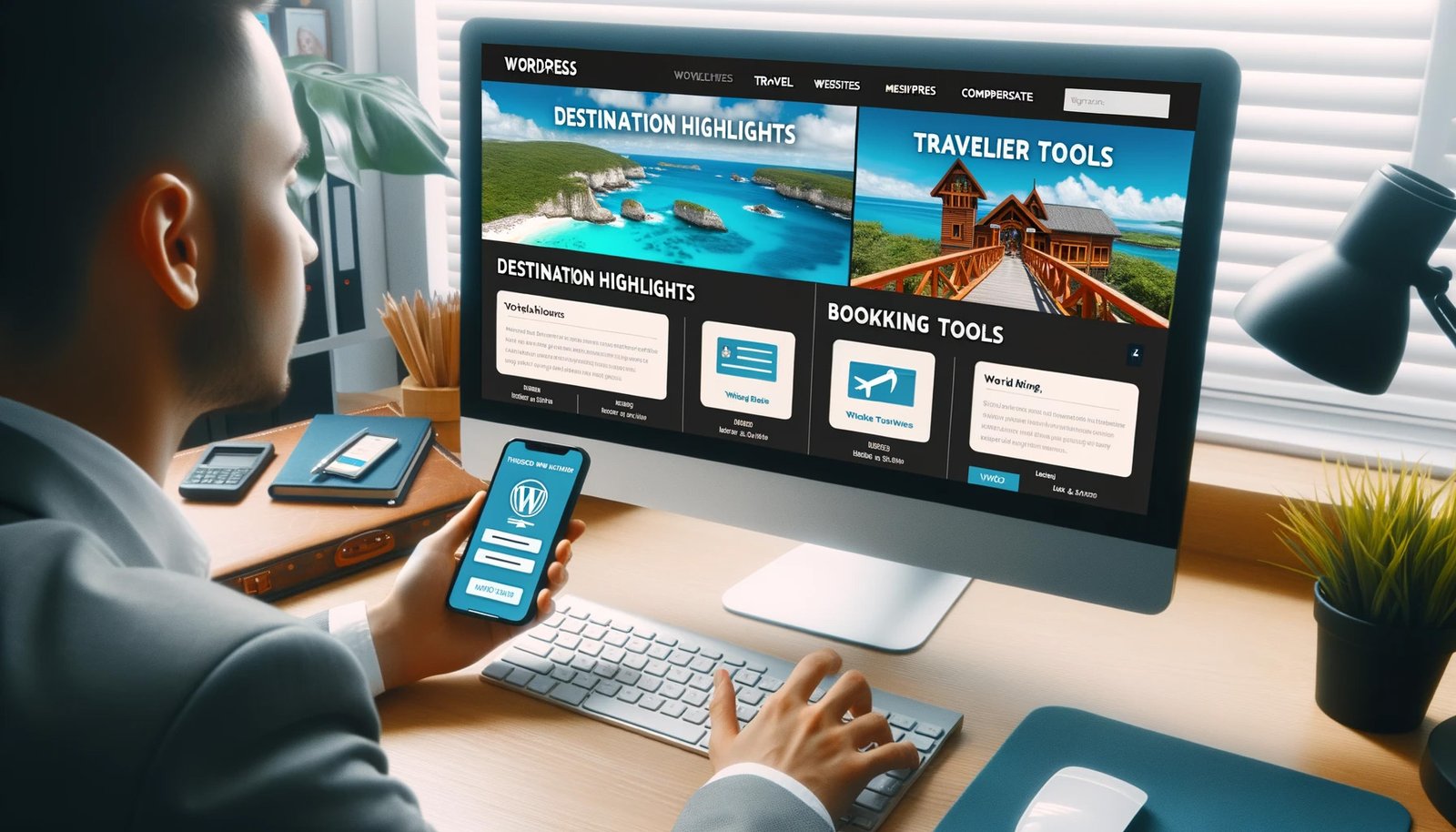Table of Contents
Toggle- Introduction – Tour and Travel Websites with WordPress
- Embarking on the Journey: How to Create a WordPress Tour Website from Scratch
- Designing the Itinerary: How to Choose and Customize a WordPress Tour Theme
- Crafting the Narrative: How to Add Pages, Posts, Images, and Videos
- Engaging with Travelers: How to Add a Blog and Contact Form
- Spreading the Word: How to Promote and Optimize Your WordPress Tour Website
- Ensuring Smooth Journeys: How to Improve Security and Maintain Your Website
- Exploring the Landscape: Best WordPress Tour Themes and Plugins
- Learning from Journeys: WordPress Tour Website Case Studies
- Staying Ahead: WordPress Tour Website Trends for 2023
- Broadening Horizons: Diversifying with WordPress Travel Websites
- Monetizing Adventures: Strategies for Your WordPress Travel Website
- The Nomadic Lifestyle: How to Travel the World While Running Your Website
- Conclusion
Create Engaging Tour and Travel Websites with WordPress: A Step-by-Step Guide
Introduction – Tour and Travel Websites with WordPress
The digital age has revolutionized the way we travel. From booking flights to finding the perfect hidden gem in a foreign city, the internet has become the ultimate travel companion. At the heart of this digital travel revolution lies WordPress, a platform that has empowered countless travel enthusiasts and businesses to share their adventures and services with the world.
The rise of digital platforms in the travel industry
Over the past decade, the travel industry has witnessed a seismic shift from traditional agencies to digital platforms. Websites and apps have become the primary touchpoints for travellers, offering convenience, variety, and, often, cost savings. Platforms like Airbnb, Booking.com, and TripAdvisor have not only democratized travel but have also enriched the experience by providing user reviews, photos, and interactive maps. This digital transformation has opened up a world of opportunities for both travellers and businesses.
Why WordPress is the go-to choice for travel enthusiasts and businesses
WordPress stands out in the crowded digital landscape due to its flexibility, user-friendliness, and vast ecosystem of themes and plugins. For travel enthusiasts, it offers a canvas to paint their journeys, share tips, and connect with like-minded souls. For businesses, from boutique hotels to sprawling resorts, WordPress provides the tools to showcase services, gather reviews, and even facilitate bookings. Its open-source nature means that it’s continuously evolving, staying in tune with the latest digital trends and user behaviours.

Embarking on the Journey: How to Create a WordPress Tour Website from Scratch
Creating a tour website is not just about showcasing beautiful destinations; it’s about crafting an experience, telling a story, and guiding visitors through a journey even before they pack their bags.
Understanding the needs of modern travellers
Today’s travellers are savvy, discerning, and often well-researched. They seek authentic experiences and value for money and often rely on peer reviews and recommendations. A successful tour website should cater to these needs, offering detailed itineraries, genuine testimonials, high-quality visuals, and easy navigation. It’s also essential to ensure mobile optimization, as a significant chunk of travel-related searches and bookings happen on mobile devices.
Initial considerations for setting up a tour website
Before diving into the world of WordPress, it’s crucial to outline the purpose of your website. Are you showcasing a specific destination, offering curated tours, or providing a platform for travellers to share their stories? Your website’s objective will guide its design, content, and functionality. Consider your target audience, their preferences, and behaviours. Research competitors, identify gaps in their offerings, and think about how you can differentiate your platform. Budgeting, both in terms of time and money, is also essential at this stage.
Designing the Itinerary: How to Choose and Customize a WordPress Tour Theme
In the realm of digital travel, your website’s design is the first impression, the virtual storefront that invites visitors in. Just as a traveler would be drawn to a picturesque landscape or a vibrant cityscape, your website’s design should captivate and inspire wanderlust.
The Significance of Aesthetics and Functionality in Travel Websites
Aesthetics in travel websites go beyond just pretty pictures. It’s about creating a visual narrative that transports visitors to the destination, making them feel the sun on their faces or the wind in their hair. However, beauty without functionality is like a compass without a needle. The design should be intuitive, with clear call-to-action buttons, easy navigation, and responsive design, ensuring a seamless experience across devices. Websites like Lonely Planet and National Geographic Travel are prime examples of aesthetics and functionality coalescing perfectly.
Tips for selecting a theme that resonates with your target audience
Choosing the right WordPress theme is akin to selecting the perfect vehicle for a road trip. It should be reliable, comfortable, and suited to the journey ahead. When selecting a theme, consider your audience’s demographics and preferences. For instance, a younger audience might appreciate dynamic elements like parallax scrolling, while an older demographic might prioritize readability. Always opt for themes that are regularly updated, SEO-friendly, and have good reviews. Platforms like ThemeForest offer a plethora of travel-specific themes to kickstart your journey.

Crafting the Narrative: How to Add Pages, Posts, Images, and Videos
Every journey has a story, and every story has a narrator. In the digital travel world, content is the narrator, guiding visitors through experiences, cultures, and landscapes.
Storytelling techniques for a compelling travel narrative
Travel is all about experiences, and a compelling narrative can recreate these experiences for the reader. Use descriptive language, paint vivid pictures with words, and weave in personal anecdotes to make the narrative relatable. Incorporate local lore, history, and cultural nuances to give depth to your stories. Platforms like Medium have a plethora of travelogues that can serve as inspiration.
Enhancing user experience with multimedia elements
In today’s digital age, content is not just about text. Images, videos, infographics, and even sound clips can transport readers to distant lands. Use high-quality images that capture the essence of a place. Videos, especially drone shots, can offer breathtaking perspectives of destinations. Tools like Adobe Spark can help in creating engaging multimedia content.
Engaging with Travelers: How to Add a Blog and Contact Form
In the vast expanse of the digital realm, creating a personal connection with your audience is paramount. A blog and a contact form serve as bridges, fostering this connection and ensuring your audience feels heard and valued.
The power of content in the travel industry
Content is the heartbeat of any travel website. It’s the stories of sunsets over Santorini, the aroma of street food in Bangkok, or the adrenaline rush of skydiving in New Zealand. A blog allows you to share these experiences, offering readers a window into different worlds. Moreover, consistent blogging establishes authority, builds trust, and improves SEO rankings. Websites like Travel + Leisure have mastered the art of storytelling, weaving narratives that resonate with readers.
Building connections and fostering community through interactive features
A contact form is more than just a tool for inquiries; it’s an open invitation for feedback, collaborations, and even heartwarming travel tales from readers. It humanizes your digital space, reminding readers that there’s a real person behind the screen. Platforms like Contact Form 7 for WordPress make it easy to integrate this feature.
Spreading the Word: How to Promote and Optimize Your WordPress Tour Website
In the bustling marketplace of the internet, standing out is both an art and a science. Promotion and optimization are the compass and map guiding your website to its rightful audience.
Leveraging social media and partnerships for maximum reach
Social media is the modern-day campfire, where stories are shared and adventures are planned. Platforms like Instagram, with its visual-centric approach, are goldmines for travel websites. Regular posts, engaging stories, and collaborations with influencers can amplify your reach. Additionally, forging partnerships with travel agencies, local businesses, or even other bloggers can open doors to new audiences. Websites like TripAdvisor have leveraged partnerships to expand their footprint.
SEO strategies tailored for the travel niche
Search Engine Optimization (SEO) is the wind in the sails of your website. For travel websites, local SEO, focusing on specific destinations, can drive significant traffic. Regularly updating content, optimizing for mobile, using relevant keywords, and building quality backlinks are crucial. Tools like Yoast SEO can guide WordPress users in this journey.
Ensuring Smooth Journeys: How to Improve Security and Maintain Your Website
In the realm of digital travel, ensuring a smooth journey for your visitors is paramount. This not only pertains to the user experience but also to the security and maintenance of your website.
Common threats in the travel website domain and countermeasures
The digital landscape, while vast and full of opportunities, is not without its pitfalls. Travel websites, with their rich databases of user information, can be prime targets for cyber-attacks. Common threats include SQL injections, cross-site scripting, and brute force attacks. Implementing SSL certificates, using security plugins like Wordfence, and regularly monitoring and auditing your website can act as robust countermeasures. Websites like Airbnb prioritize user data protection, setting industry standards.
The importance of regular updates and backups for uninterrupted experiences
The digital world is ever-evolving. To ensure your website remains compatible with the latest technologies and is safeguarded against new vulnerabilities, regular updates are crucial. This includes updating the WordPress core, plugins, and themes. Moreover, regular backups ensure that in the face of any mishaps, your data remains safe. Tools like UpdraftPlus can automate this process, ensuring peace of mind.
Exploring the Landscape: Best WordPress Tour Themes and Plugins
The aesthetics and functionality of your travel website play a pivotal role in captivating and retaining visitors. The right themes and plugins can elevate your website from good to exceptional.
Themes that captivate and inspire wanderlust
A theme sets the visual tone of your website. For travel websites, this means themes that are visually rich, responsive, and offer immersive experiences. Themes like Travel Way or Trawell have been crafted with the travel enthusiast in mind, offering features tailored to the industry.
Plugins that enhance functionality and user engagement
Beyond aesthetics, the functionality of your website is crucial. Plugins can extend your website’s capabilities, offering features like booking systems, interactive maps, and social media integrations. Plugins such as WP Travel or Traveler are specifically designed for travel websites, ensuring users have a seamless experience.
Learning from Journeys: WordPress Tour Website Case Studies
The digital travel landscape is dotted with success stories, each offering unique insights and strategies. By analyzing these successful tour websites, one can glean actionable strategies and avoid common pitfalls.
Analyzing successful tour websites and their strategies
One standout example is Lonely Planet. What began as a humble travel guidebook has transformed into a digital travel powerhouse. Their website is a masterclass in user experience, content curation, and community engagement. Another notable mention is Nomadic Matt, a travel blogger who turned his passion into a profitable venture. His website’s success can be attributed to authentic storytelling, consistent content updates, and effective monetization strategies.
Key takeaways for aspiring travel website owners
From these case studies, several key lessons emerge. Authenticity is paramount; travellers seek genuine experiences and stories. Consistency in content updates keeps the audience engaged and returning for more. Lastly, a clear monetization strategy, be it through affiliate marketing, sponsored content, or direct sales, can turn passion into profit.
Staying Ahead: WordPress Tour Website Trends for 2023
The digital travel domain is ever-evolving, with new trends emerging each year. Staying updated with these trends ensures your website remains relevant and competitive.
Predictions for the travel digital world in the coming year
Virtual Reality (VR) tours are poised to become mainstream, offering immersive experiences from the comfort of one’s home. Sustainable travel, focusing on eco-friendly practices and responsible tourism, will gain more traction. Additionally, with the rise of AI, personalized travel recommendations based on user behaviour and preferences will enhance user experience.
Adapting to innovations and changing traveller behaviours
To stay ahead, it’s crucial to be adaptable. Integrating VR capabilities, highlighting sustainable practices, or employing AI for personalized experiences can set your website apart. Observing platforms like TripAdvisor can offer insights into evolving traveller behaviours and preferences.
Broadening Horizons: Diversifying with WordPress Travel Websites
In the vast realm of travel, there are numerous niches and avenues to explore. Diversifying your content can cater to a broader audience and offer varied experiences.
The allure of travel blogs, podcasts, and video channels
Travel blogs like The Blonde Abroad offer personal insights and experiences, resonating with readers on a personal level. Podcasts, such as the Indie Travel Podcast, provide auditory experiences, while video channels like Travel+Leisure on YouTube offer visual escapades.
Setting up booking and membership features for added revenue streams
Beyond content, offering services like booking or exclusive memberships can be lucrative. Plugins like Bookly can facilitate booking services, while MemberPress can help set up exclusive content for members.

Monetizing Adventures: Strategies for Your WordPress Travel Website
In the vast expanse of the digital travel realm, turning passion into profit is the dream of many. With the right strategies, your WordPress travel website can become not just a platform for sharing experiences but also a lucrative venture.
Exploring various monetization avenues in the travel domain
There’s a myriad of ways to monetize a travel website. Affiliate marketing, for instance, is a popular choice. Websites can partner with travel agencies, airlines, or accommodation providers and earn a commission for every booking made through their referral. Platforms like CJ Affiliate or Amazon Associates offer a plethora of products and services to promote. Sponsored content is another avenue where brands pay for exposure on your platform. This could be in the form of blog posts, videos, or social media shoutouts.
Best practices for ethical and effective monetization
While monetization is essential, maintaining trust with your audience is paramount. Always disclose affiliate links and sponsored content to your readers. Platforms like AdThrive or Mediavine can help manage ads effectively, ensuring they don’t hamper user experience. Remember, authenticity is key. Promote products and services you genuinely believe in and have perhaps even experienced yourself.
The Nomadic Lifestyle: How to Travel the World While Running Your Website
In today’s digital age, the dream of travelling the world while maintaining a successful website is more achievable than ever. With the right tools and strategies, you can balance your wanderlust with your entrepreneurial spirit.
Balancing travel passions with business responsibilities
Running a website while travelling requires discipline and effective time management. Utilizing tools like Trello for task management or Hootsuite for scheduling social media posts can be invaluable. It’s also essential to have reliable internet connectivity. Investing in a global SIM card or a portable Wi-Fi device can ensure you’re always connected.
Tools and techniques for remote website management
WordPress offers a range of plugins designed for remote management. Plugins like ManageWP allow you to manage multiple WordPress websites from a single dashboard. Cloud-based tools like Google Drive or Dropbox ensure you have access to your files from anywhere in the world. Lastly, always have a backup strategy. Plugins like UpdraftPlus can automate this process, giving you peace of mind.
Conclusion
The journey of creating and managing a WordPress travel website is both challenging and rewarding. In the ever-evolving digital landscape, staying updated, authentic, and engaged with your audience is key. As we reflect on the transformative power of WordPress in the travel domain, it’s evident that with passion, the right tools, and strategies, anyone can embark on a successful digital travel adventure. Whether you’re a novice looking to share your travel tales or a business aiming to carve a niche in the travel industry, WordPress offers the tools and flexibility to help you achieve your goals.
-
- Why is WordPress a preferred choice for creating tour and travel websites?
- Discussing the platform’s flexibility, extensive theme options, and plugins tailored for the travel industry.
- How can I showcase travel destinations attractively on my WordPress website?
- Tips on using high-quality images, sliders, and interactive maps to engage visitors.
- What are the essential features every tour and travel website should have?
- Highlighting itinerary displays, booking systems, customer reviews, and multilingual support.
- How can I integrate a booking system into my WordPress travel website?
- Introduction to popular booking plugins and their features, such as calendar integration and payment gateways.
- What strategies can I use to make my travel website mobile-friendly?
- Discussing responsive design, mobile-optimized images, and touch-friendly navigation elements.
- How can I use my travel website to build and engage with a community?
- Tips on integrating social media feeds, encouraging user-generated content, and fostering discussions through comments.
- What are the best practices for showcasing customer reviews and testimonials?
- Overview of plugins that display reviews, the importance of genuine feedback, and strategies to encourage customers to leave reviews.
- How can I optimize my travel website for search engines to attract more visitors?
- Discussing SEO best practices specific to the travel industry, such as local SEO and optimizing for travel-related queries.
- What security measures should I take to protect my travel website’s data and my customers’ information?
- Emphasizing the importance of SSL certificates, regular backups, and secure payment gateways.
- How can I effectively use content marketing to promote destinations and packages on my travel website?
- Tips on creating engaging blog posts, videos, and infographics that highlight travel experiences and destinations.







